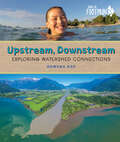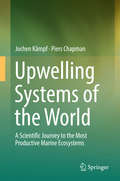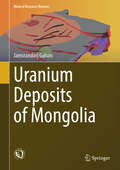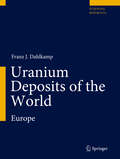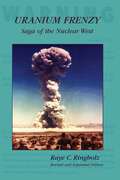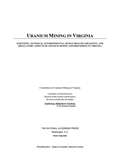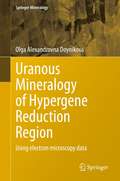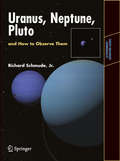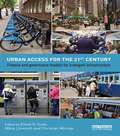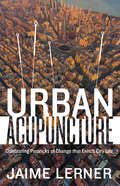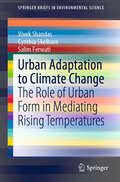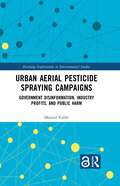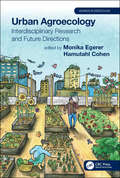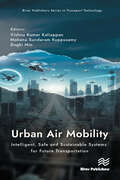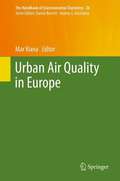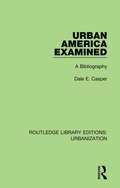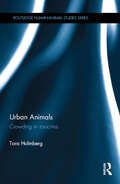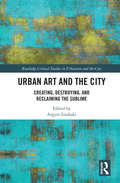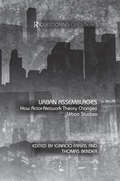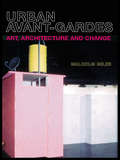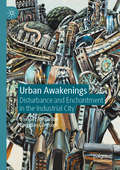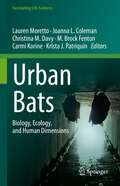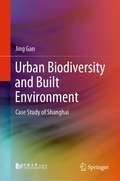- Table View
- List View
Upstream, Downstream: Exploring Watershed Connections (Orca Footprints #21)
by Rowena RaeDo you know your watershed address? We all have one, whether we live high up in a mountain, on an inland prairie or near the coast. A watershed is an area of land that channels rain and snowmelt into streams, rivers and oceans. Our lives are deeply intertwined with land and water and all the connections between them. Day-to-day activities—like brushing our teeth, eating a meal, getting a ride in a car or even using an electronic device—have consequences for our own or someone else's watershed. Over the centuries we've changed the land by farming it, cutting down the trees on it, digging into it and building on it. We've also learned how to control water—where it goes and how much flows. Upstream, Downstream explores the consequences of the pressures people place on watersheds and highlights some of the heroes making a difference for watersheds around world. The epub edition of this title is fully accessible.
Upwelling Systems of the World
by Jochen Kämpf Piers ChapmanUpwelling systems are special places in the oceans where nutrient-enriched water is brought into the euphotic zone to fuel phytoplankton blooms that, via marine food-web interactions, create the world's richest fish resources. This book introduces the reader to the interdisciplinary science of upwelling and provides a comprehensive overview of the world's most productive marine ecosystems in the context of climate variability, climate change and human exploitation. This material presented is suitable for undergraduate and postgraduate study or just for anyone interested to learn about the creation of life in the oceans and how this is compromised by human activities.
Uranium Deposits of Mongolia (Mineral Resource Reviews)
by Jamsrandorj GalsanThis book contained the geological investigation condition of the territory of Mongolia for uranium, the geodynamic position of the uranium mineralization. To delineate metallogenic zoning for uranium in the territory of Mongolia, we determined geodynamic settings based on the development of geological complexes and formations with which uranium mineralization is related both genetically and spatially. It should be noted that a larger number of NRE radio-geochemical anomalies are associated with various types of rocks of different ages and genesis. However, a careful study of the distribution and composition of these rocks showed that uranium mineralization is associated with igneous rocks of active continental margins and their back-arc (back-arc) structures of rift origin. In addition, mostly in Eastern and Northern Mongolia, uranium mineralization is also associated with alkaline bimodal volcanic of the rift origin. This pattern has been noted previously by various researchers. The main regularities in the distribution of uranium objects based on the geodynamic position of tectonics are revealed, uranium-bearing provinces, zones and districts are characterized, uranium-ore epochs are identified, the main genetic types of genetic uranium deposits according to the IAEA classification of uranium deposits, the state of uranium reserves and resources in Mongolia is given. The characteristics of the geological structure of all uranium deposits in Mongolia are given. According to the classification of uranium deposits (Franz J. Dahlkamp, 2015) by the IAEA, the following types of uranium deposits can be distinguished on the territory of Mongolia: sandstone deposits; deposits related with volcanic rocks; deposits related with granites; deposits related with intrusions; deposits related with metasomatites; deposits related with lignites and coals; deposits related with phosphorites; deposits related with black shales; near-surface deposits, of which the first 2 types are the most studied. The rest are distinguished only by direct prospecting signs and need detailed study in the future and have good prospects for increasing Mongolia's uranium reserves. The main share (66.69%) of Mongolia's reserves falls on the deposits of the East Mongolian and Gobi uranium zones, where sandstone deposits are common. Deposits related with volcanic rocks in the Eastern zone occupy about 25.19% of Mongolia's uranium reserves. The book is intended not only for geologists, specialists and scientists in the field of uranium geology, but for investors in geological exploration and exploitation in Mongolia for uranium.
Uranium Deposits of the World
by Franz J. DahlkampUranium Deposits of the World, in four volumes, comprises an unprecedented compilation of data and overviews of the key uranium regions throughout the globe. It offers not only a complete uranium-resource reference based on the latest research but also access to previously unavailable data. Each country and region receives an analytical overview followed by the detailed geologically- and economically-relevant synopsis of the individual regions and fields, including: location and magnitude of uranium districts and deposits; principal features of uranium districts; and characteristics of selected deposits. The description of districts and deposits includes sections on geology, alteration, mineralogy, shape and dimensions, ore controls or recognition criteria, and metallogenetic aspects. A typological classification of uranium deposits is added to give an overview of principal criteria of deposit types and related nomenclature. The set also provides readers access to the voluminous literature via the comprehensive bibliography of uranium-related publications. Abundantly illustrated with information-laden maps and charts throughout, this reference work is an indispensable tool for geologists, mining companies, government agencies, and others with interest in key natural resources. The four volumes of Uranium Deposits of the World, available as set, cover the world's populated continents: Asia; Europe; Australia, Oceania, and Africa; and USA, and Latin America.
Uranium Frenzy: Saga of the Nuclear West
by Raye RingholzNow expanded to include the story of nuclear testing and its consequences, Uranium Frenzy has become the classic account of the uranium rush that gripped the Colorado Plateau region in the 1950s. Instigated by the U.S. government's need for uranium to fuel its growing atomic weapons program, stimulated by Charlie Steen's lucrative Mi Vida strike in 1952, manned by rookie prospectors from all walks of life, and driven to a fever pitch by penny stock promotions, the boom created a colorful era in the Four Corners region and Salt Lake City (where the stock frenzy was centered) but ultimately went bust. The thrill of those exciting times and the good fortune of some of the miners were countered by the darker aspects of uranium and its uses. Miners were not well informed regarding the dangers of radioactive decay products. Neither the government nor anyone else expended much effort educating them or protecting their health and safety. The effects of exposure to radiation in poorly ventilated mines appeared over time.
Uranium Mining in Virginia: Scientific, Technical, Environmental, Human Health and Safety, and Regulatory Aspects of Uranium Mining and Processing in Virginia
by Committee on Uranium Mining in VirginiaUranium mining in the Commonwealth of Virginia has been prohibited since 1982 by a state moratorium, although approval for restricted uranium exploration in the state was granted in 2007. Uranium Mining in Virginia examines the scientific, technical, environmental, human health and safety, and regulatory aspects of uranium mining, milling, and processing as they relate to the Commonwealth of Virginia for the purpose of assisting the Commonwealth to determine whether uranium mining, milling, and processing can be undertaken in a manner that safeguards the environment, natural and historic resources, agricultural lands, and the health and well-being of its citizens. According to this report, if Virginia lifts its moratorium, there are "steep hurdles to be surmounted" before mining and processing could take place within a regulatory setting that appropriately protects workers, the public, and the environment, especially given that the state has no experience regulating mining and processing of the radioactive element. The authoring committee was not asked to recommend whether uranium mining should be permitted, or to consider the potential benefits to the state were uranium mining to be pursued. It also was not asked to compare the relative risks of uranium mining to the mining of other fuels such as coal. This book will be of interest to decision makers at the state and local level, the energy industry, and concerned citizens.
Uranous Mineralogy of Hypergene Reduction Region: Using electron microscopy data (Springer Mineralogy)
by Olga Alexandrovna DoynikovaThis book offers a comprehensive view of the valuable uranium ores and analytical electron microscopy methods, including electron microdiffraction principles, an essential technique for studying uranous minerals.This book also explains the laws governing the formation of uranium mineral accumulations, based on concepts published by the renowned Russian mineralogist L.N. Belova. It addresses all types of ore uranium concentrations in the hypergene region and schematizes all uranium mineral formation processes. Readers will also find selected examples of different genetic types of uranium deposits of black sooty ores; the data gathered from all findings on ningyoite worldwide, and new crystal chemistry data on tetravalent uranium phosphates.
Uranus, Neptune, and Pluto and How to Observe Them
by Richard Schmude Jr.This book is for two groups of people: those who want to study the remote planets with amateur astronomical equipment, and those who are just interested in learning about our knowledge of the remote planets. The Remote Planets, and How to Observe them is unique in that it gives a completely up-to-date summary of our current knowledge of the remote planets, and also explains how amateur astronomers can contribute to our knowledge of the remote planets. Readers are given some inspiring examples of people who, with modest commercially-made equipment, have made important contributions to our scientific knowledge. The observational section goes into great detail, including optical and CCD photometry, occultation measurements, imaging (including stacking and enhancement techniques) and polarization measurements. There are finder charts (from 2010 to 2026), complete with two sets of star-magnitudes in an appendix (one set of magnitudes are for photoelectric photometry and the other set is for visual photometry)
Urban Access for the 21st Century: Finance and Governance Models for Transport Infrastructure
by Christian Wolmar M Elliott D. SclarThis book sets out a road map for the provision of urban access for all. For most of the last century cities have followed a path of dependency on car dominated urban transport favouring the middle classes. Urban Access for the 21st Century seeks to change this. Policies need to be more inclusive of the accessibility needs of the urban poor. Change requires redesigning the existing public finance systems that support urban mobility. The aim is to diminish their embedded biases towards automobile-based travel. Through a series of chapters from international contributors, the book brings together expertise from different fields. It shows how small changes can incentivize large positive developments in urban transport and create truly accessible cities.
Urban Acupuncture
by Jaime LernerDuring his three terms as mayor of Curitiba, Brazil in the 1970s and '80s, architect and urbanist Jaime Lerner transformed his city into a global model of the sustainable and livable community. From the pioneering Bus Rapid Transit system to parks designed to catch runoff and reduce flooding and the creation of pedestrian-only zones, Lerner has been the driving force behind a host of innovative urban projects. In more than forty years of work in cities around the globe, Lerner has found that changes to a community don't need to be large-scale and expensive to have a transformative impact--in fact, one block, park, or a single person can have an outsized effect on life in the surrounding city. In Urban Acupuncture, Lerner celebrates these "pinpricks" of urbanism--projects, people, and initiatives from around the world that ripple through their communities to uplift city life. With meditative and descriptive prose, Lerner brings readers around the world to streets and neighborhoods where urban acupuncture has been practiced best, from the bustling La Boqueria market in Barcelona to the revitalization of the Cheonggyecheon River in Seoul, South Korea. Through this journey, Lerner invites us to re-examine the true building blocks of vibrant communities--the tree-lined avenues, night vendors, and songs and traditions that connect us to our cities and to one another. Urban Acupuncture is the first of Jaime Lerner's visionary work to be published in English. It is a love letter to the elements that make a street hum with life or a neighborhood feel like home, penned by one of the world's most successful advocates for sustainable and livable urbanism.
Urban Adaptation to Climate Change: The Role of Urban Form in Mediating Rising Temperatures (SpringerBriefs in Environmental Science)
by Vivek Shandas Cynthia Skelhorn Salim FerwatiThis book presents the findings of a three-year study on urban heat in Doha, Qatar, and discusses guidelines and strategies for planning agencies to consider in the context of moderating temperatures to provide pedestrians with greater access to outdoor spaces and greater choice in modes of transport. If modifying urban form can reduce extreme temperatures in one of the hottest places on the planet, then perhaps other communities can learn how to create livable cities during a time of rapid changes to the climate. In fact, despite the periods of extreme heat, strategic planning and management of urban areas can improve residents’ and visitors’ ability to live, work, and move throughout the city comfortably. Doha, Qatar, a city with one of the most extreme climates on earth, has undergone rapid development over the past 40 years. Although cities in the Middle East are expanding at three times the international average (UN Report, 2012), the rapid population and physical growth remain largely unexamined, particularly in terms of the unique conditions, qualities, and characteristics that give rise to these emerging centres. Speed, quality, and extent of urbanization impact neighbourhood-scale environmental conditions, and this book provides evidence that urban forms and materials can help to mediate temporal variation in microclimates and that landscape modifications can potentially reduce temperatures and increase accessibility to outdoor environments. By applying the lessons in this book, communities around the world can better adapt to the increasing frequency, duration and intensity of extreme heat.
Urban Aerial Pesticide Spraying Campaigns: Government Disinformation, Industry Profits, and Public Harm (Routledge Explorations in Environmental Studies)
by Manuel ValléeThis book examines social processes that have contributed to growing pesticide use, with a particular focus on the role governments play in urban aerial pesticide spraying operations. Beyond being applied to sparsely populated farmland, pesticides have been increasingly used in densely populated urban environments, and when faced with invasive species, governments have resorted to large-scale aerial pesticide spraying operations in urban areas. This book focuses on New Zealand's 2002–2004 pesticide campaign to eradicate the Painted Apple Moth, which is the largest operation of its kind in world history, whether we consider its duration (29 months), its scope (at its peak the spraying zone was 10,632 hectares/26,272 acres), the number of sprayings that were administered (the pesticide was administered on 60 different days), or the number of people exposed to the spraying (190,000+). This book provides an in-depth understanding of the social processes that contributed to the incursion, why the government sought to eradicate the moth through aerial pesticide spraying, the ideological strategies they used to build and maintain public support, and why those strategies were effective. Urban Aerial Pesticide Spraying Campaigns will be of great interest to students and researchers of pesticides, environmental sociology, environmental history, environmental studies, political ecology, geography, medical sociology, and science and technology studies.
Urban Aerial Pesticide Spraying Campaigns: Government Disinformation, Industry Profits, and Public Harm (Routledge Explorations in Environmental Studies)
by Manuel ValléeThis book examines social processes that have contributed to growing pesticide use, with a particular focus on the role governments play in urban aerial pesticide spraying operations.Beyond being applied to sparsely populated farmland, pesticides have been increasingly used in densely populated urban environments, and when faced with invasive species, governments have resorted to large-scale aerial pesticide spraying operations in urban areas. This book focuses on New Zealand's 2002–2004 pesticide campaign to eradicate the Painted Apple Moth, which is the largest operation of its kind in world history, whether we consider its duration (29 months), its scope (at its peak the spraying zone was 10,632 hectares/26,272 acres), the number of sprayings that were administered (the pesticide was administered on 60 different days), or the number of people exposed to the spraying (190,000+). This book provides an in-depth understanding of the social processes that contributed to the incursion, why the government sought to eradicate the moth through aerial pesticide spraying, the ideological strategies they used to build and maintain public support, and why those strategies were effective.Urban Aerial Pesticide Spraying Campaigns will be of great interest to students and researchers of pesticides, environmental sociology, environmental history, environmental studies, political ecology, geography, medical sociology, and science and technology studies.The Open Access version of this book, available at http://www.taylorfrancis.com, has been made available under a Creative Commons Attribution-Non Commercial-No Derivatives (CC-BY-NC-ND) 4.0 license.
Urban Agroecology: Interdisciplinary Research and Future Directions (Advances in Agroecology #23)
by Monika Egerer Hamutahl CohenToday, 20 percent of the global food supply relies on urban agriculture: social-ecological systems shaped by both human and non-human interactions. This book shows how urban agroecologists measure flora and fauna that underpin the ecological dynamics of these systems, and how people manage and benefit from these systems. It explains how the sociopolitical landscape in which these systems are embedded can in turn shape the social, ecological, political, and economic dynamics within them. Synthesizing interdisciplinary approaches in urban agroecology in the natural and social sciences, the book explores methodologies and new directions in research that can be adopted by scholars and practitioners alike. With contributions from researchers utilizing both social and natural science approaches, Urban Agroecology describes the current social-environmental understandings of the science, the movement and the practices in urban agroecology. By investigating the role of agroecology in cities, the book calls for the creation of spaces for food to be sustainably grown in urban spaces: an Urban Agriculture (UA) movement. Essential reading for graduate students, practitioners, policy makers and researchers, this book charts the course for accelerating this movement.
Urban Air Mobility: Intelligent, Safe and Sustainable Systems for Future Transportation
by Vishnu Kumar Kaliappan Mohana Sundaram Kuppusamy Dugki MinThis book is a resource for engineers and researchers to develop intelligent, safe, and sustainable systems for urban air mobility. In recent years, the growth of the world’s urban population has increased tremendously, and it is predicted that by 2040, 70% of the world population will be living in an urban setting. Existing ground transportation will be unable to cope with such an expansion, especially as congestion and over-crowding becomes more common. An answer may be found with the advent of recent technologies such as urban air mobility, which may play a vital role in providing solutions for public transportation.The impact of modelling, analysis and application of intelligent algorithms is very much at the core of the design and implementation of Urban Air Mobility. The various chapters are configured to address the challenges in modelling, analysis, navigation, traffic control, battery efficiency, safety and security in terms of Artificial intelligence techniques.
Urban Air Quality in Europe
by Mar VianaThis book provides an overview of air quality in urban environments in Europe, focusing on air pollutant emission sources and formation mechanisms, measurement and modeling strategies, and future perspectives. The emission sources described are biomass burning, vehicular traffic, industry and agriculture, but also African dust and long-range transport of pollutants across the European regions. The impact of these emission sources and processes on atmospheric particulate matter, ozone, nitrogen oxides and volatile and semi-volatile organic compounds is discussed and critical areas for particulate matter and nitrogen dioxide in Europe are identified. Finally, this volume presents future perspectives, mainly regarding upcoming air quality monitoring strategies, metrics of interest, such as submicron and nanoparticles, and indoor and outdoor exposure scenarios.
Urban Air Quality in Europe (The Handbook of Environmental Chemistry #26)
by Mar VianaThis book provides an overview of air quality in urban environments in Europe, focusing on air pollutant emission sources and formation mechanisms, measurement and modeling strategies, and future perspectives. The emission sources described are biomass burning, vehicular traffic, industry and agriculture, but also African dust and long-range transport of pollutants across the European regions. The impact of these emission sources and processes on atmospheric particulate matter, ozone, nitrogen oxides and volatile and semi-volatile organic compounds is discussed and critical areas for particulate matter and nitrogen dioxide in Europe are identified. Finally, this volume presents future perspectives, mainly regarding upcoming air quality monitoring strategies, metrics of interest, such as submicron and nanoparticles, and indoor and outdoor exposure scenarios.
Urban America Examined: A Bibliography (Routledge Library Editions: Urbanization #1)
by Dale E. CasperOriginally published in 1985 Urban America Examined, is a comprehensive bibliography examining the urban environment of the United States. The book is split into sections corresponding to the four main geographic regions of the country, looking respectively at research conducted in the East, South, Midwest and West. The book provides a broad cross section of sources, from books to periodicals and covers a range of interdisciplinary issues such as social theory, urbanization, the growth of the city, ethnicity, socialism and US politics.
Urban Animals: Crowding in zoocities (Routledge Human-Animal Studies Series)
by Tora HolmbergThe city includes opportunities as well as constraints for humans and other animals alike. Urban animals are often subjected to complaints; they transgress geographical, legal as and cultural ordering systems, while roaming the city in what is often perceived as uncontrolled ways. But they are also objects of care, conservation practices and bio-political interventions. What then, are the "more-than-human" experiences of living in a city? What does it mean to consider spatial formations and urban politics from the perspective of human/animal relations?This book draws on a number of case studies to explore urban controversies around human/animal relations, in particular companion animals: free ranging dogs, homeless and feral cats, urban animal hoarding and "crazy cat ladies". The book explores ‘zoocities’, the theoretical framework in which animal studies meet urban studies, resulting in a reframing of urban relations and space. Through the expansion of urban theories beyond the human, and the resuscitation of sociological theories through animal studies literature, the book seeks to uncover the phenomenon of ‘humanimal crowding’, both as threats to be policed, and as potentially subversive. In this book, a number of urban controversies and crowding technologies are analysed, finally pointing at alternative modes of trans-species urban politics through the promises of humanimal crowding - of proximity and collective agency. The exclusion of animals may be an urban ideology, aiming at social order, but close attention to the level of practice reveals a much more diverse, disordered, and perhaps disturbing experience.
Urban Art and the City: Creating, Destroying, and Reclaiming the Sublime (Routledge Studies in Urbanism and the City)
by Argyro LoukakiThis book offers original interdisciplinary insights into cities as a diachronic creation of urban art. It engages in a sequence of historical perspectives to examine urban space as an object of apparent quasi-cycles and processes of constitution, exaltation, imitation, contestation and redemption through art. Urban art transforms the city into a human-made sublime which is explored in the context of the Eastern Mediterranean. The book probes this process primarily through the example of Athens and Byzantine Constantinople, but also Jerusalem, Cyprus and regional cities, revealing how urban space unavoidably encompasses a spatial and temporal palimpsest which is constantly emerging. It presents new ideas for both the theorization and sensuous conception of artistic reality, architecture, and planning attributes. These extend from archaic, classical and Byzantine urban splendour to current urban decline as constitution and attack on the sublime and back. Urban processes of contestation and redemption respond recently to the new ‘imperialism of debt’ and the positivist, technocratic understandings and demands of Euro-governments and neoliberal institutions, while still evoking older forms of spatial power.Offering fresh notions on art, architecture, space, antiquity, (post)-modernity and politics of the region, this book will appeal to scholars and students of geography, urban studies, art, restoration, and film theory, architecture, landscape design, planning, anthropology, sociology and history.
Urban Assemblages: How Actor-Network Theory Changes Urban Studies (Questioning Cities)
by Thomas Bender Ignacio FaríasThis book takes it as a given that the city is made of multiple partially localized assemblages built of heterogeneous networks, spaces, and practices. The past century of urban studies has focused on various aspects—space, culture, politics, economy—but these too often address each domain and the city itself as a bounded and cohesive entity. The multiple and overlapping enactments that constitute urban life require a commensurate method of analysis that encompasses the human and non-human aspects of cities—from nature to socio-technical networks, to hybrid collectivities, physical artefacts and historical legacies, and the virtual or imagined city. This book proposes—and its various chapters offer demonstrations—importing into urban studies a body of theories, concepts, and perspectives developed in the field of science and technology studies (STS) and, more specifically, Actor-Network Theory (ANT). The essays examine artefacts, technical systems, architectures, place and eventful spaces, the persistence of history, imaginary and virtual elements of city life, and the politics and ethical challenges of a mode of analysis that incorporates multiple actors as hybrid chains of causation. The chapters are attentive to the multiple scales of both the object of analysis and the analysis itself. The aim is more ambitious than the mere transfer of a fashionable template. The authors embrace ANT critically, as much as a metaphor as a method of analysis, deploying it to think with, to ask new questions, to find the language to achieve more compelling descriptions of city life and of urban transformations. By greatly extending the chain or network of causation, proliferating heterogeneous agents, non-human as well as human, without limit as to their enrolment in urban assemblages, Actor-Network Theory offers a way of addressing the particular complexity and openness characteristic of cities. By enabling an escape from the reification of the city so common in social theory, ANT’s notion of hybrid assemblages offers richer framing of the reality of the city—of urban experience—that is responsive to contingency and complexity. Therefore Urban Assemblages is a pertinent book for students, practitioners and scholars as it aims to shift the parameters of urban studies and contribute a meaningful argument for the urban arena which will dominate the coming decades in government policies.
Urban Avant-Gardes: Art, Architecture and Change
by Malcolm MilesUrban Avant-Gardes presents original research on a range of recent contemporary practices in and between art and architecture giving perspectives from a wide range of disciplines in the arts, humanities and social sciences that are seldom juxtaposed, it questions many assumptions and accepted positions. This book looks back to past avant-gardes from the nineteenth and twentieth centuries examining the theoretical and critical terrain around avant-garde cultural interventions, and profiles a range of contemporary cases of radical cultural practices. The author brings together material from a wide range of disciplines to argue for cultural intervention as a means to radical change, while recognizing that most such efforts in the past have not delivered the dreams of their perpetrators. Distinctive in that it places works of the imagination in the political and cultural context of environmentalism, this book asks how cultural work might contribute to radical social change. It is equally concerned with theory and practice - part one providing a theoretical framework and part two illustrating such frameworks with examples.
Urban Awakenings: Disturbance and Enchantment in the Industrial City
by Samuel Alexander Brendan GleesonThis book presents a series of urban investigations undertaken in the metropolis of Melbourne. It is based on the idea that ‘enchantment’ as an affective state is important to ethical and political engagement. Alexander and Gleeson argue that a sense of enchantment can give people the impulse to care and engage in an increasingly troubled world, whereas disenchantment can lead to resignation. Applying and extending this theory to the urban landscape, the authors walk their home city with eyes open to the possibility of seeing and experiencing the industrial city in different ways. This unique methodology, described as ‘urban tramping’, positions the authors as freethinking freewalkers of the city, encumbered only with the duty to look through the delusions of industrial capitalism towards its troubled, contradictory soul. These urban investigations were disrupted midway by COVID-19, a plague that ended up confirming the book’s central thesis of a fractured modernity vulnerable to various internal contradictions.
Urban Bats: Biology, Ecology, and Human Dimensions (Fascinating Life Sciences)
by M. Brock Fenton Lauren Moretto Joanna L. Coleman Christina M. Davy Carmi Korine Krista J. PatriquinThe Anthropocene is the “age of human influence”, an epoch well known for its urban impact. More than half of all people already live in cities, and this proportion is expected to rise to almost 70 percent by 2050. Like other species in urban areas, bats must contend with the pressures of profound and irreversible land cover change and overcome certain unique challenges, such as the high density of roads, lights, glass, and free-ranging domestic animals. Research on urban bats in recent decades indicates that when it comes to urban life, some bats are synanthropes. In other words, although most species of bats are negatively impacted by urbanisation, many appear to not only succeed, but also thrive in cities and towns. This observation has inspired interesting questions about bats in relation to urbanisation. Which traits and behaviours equip bats for urban success? What features of urban areas increase the likelihood that bats will successfully persist there or even colonize new areas? And how does the success of urban bats affect co-habiting humans?Our book explores the interactions between bats and urban environments through case studies and reviews. Understanding how different species interact with urban environments can reveal potential opportunities to mitigate urban threats to bats and threats posed by bats to other urban organisms, including humans. With this book, we thus aspire to provide a knowledge base to help guide current and future efforts to conserve bats.
Urban Biodiversity and Built Environment: Case Study of Shanghai
by Jing GanThis book proposes the concept of urban multiple habitats and then analyzes its corresponding classification, function and potential supply capability. It provides an analysis framework for studying the relationship between urban biodiversity and built environment, and for considering the loss of urban habitats caused by high-density development. It argues that urban biodiversity is a key indicator for assessing urban ecosystem services. On this basis, the book then presents a case study mainly focusing on wild birds in Shanghai, as urban wild birds and their species could be viewed as an essential indicator for evaluating healthy ecosystem of contemporary cities. Based on the empirical findings, the book proposes an assessment model for urban biodiversity performance and a range of principles, strategies and key indicators regarding the optimization of urban planning and design practice to enhance urban biodiversity performance.
